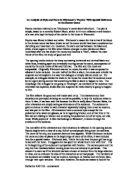To what extent are the audience prepared for Marion’s murder in Alfred Hitchcock’s Psycho?
To what extent are the audience prepared for Marion's murder in Alfred Hitchcock's Psycho?
This essay is about Alfred Hitchcock's film "Psycho". Psycho was made in 1960 and starred Janet Leigh (Marion Crane), Vera Miles (Lila), Anthony Perkins (Norman Bates) and John Gavin (Sam- Marion's lover). The music was by Bernard Herman.
In this essay I will investigate costume, camera angles, soundtrack and lighting, and explain how all of these contribute to preparing the audience for Marion's murder. Even though colour television was available in 1960 Alfred Hitchcock chose to shoot the film in black and white to add to the effect and because he thought that it would have been too violent, for the time it was made, in colour.
At the very start of "Psycho" there is a panoramic shot of the city. The camera then focuses on one building and gradually zooms into one room of this building. This is trying to show the viewers that it is just an ordinary city with many people doing their own things but the camera is only interested in the occupants of this room.
Inside the room the audience see a man and a woman who is wearing white underwear. The fact that she is wearing white underwear is important because the colour white is associated with purity and innocence. This makes the audience feel more kindly towards her, even though the fact that she is having an affair with a married man is revealed in their conversation. At this point in the film the audience are expected to see Marion as an attractive bad girl and think she may be in danger because the bad girl in a film usually ends up being murdered. Because Marion wants to marry Sam (her boyfriend), the audience think that she is not entirely bad.
When Marion is packing her suitcase after stealing the $40 000 she only packs dark coloured clothes and changes her clothes and underwear to black. This change is significant because it shows that she has done something that is not morally correct and she is not as virginal as she was before she stole the money.
This essay is about Alfred Hitchcock's film "Psycho". Psycho was made in 1960 and starred Janet Leigh (Marion Crane), Vera Miles (Lila), Anthony Perkins (Norman Bates) and John Gavin (Sam- Marion's lover). The music was by Bernard Herman.
In this essay I will investigate costume, camera angles, soundtrack and lighting, and explain how all of these contribute to preparing the audience for Marion's murder. Even though colour television was available in 1960 Alfred Hitchcock chose to shoot the film in black and white to add to the effect and because he thought that it would have been too violent, for the time it was made, in colour.
At the very start of "Psycho" there is a panoramic shot of the city. The camera then focuses on one building and gradually zooms into one room of this building. This is trying to show the viewers that it is just an ordinary city with many people doing their own things but the camera is only interested in the occupants of this room.
Inside the room the audience see a man and a woman who is wearing white underwear. The fact that she is wearing white underwear is important because the colour white is associated with purity and innocence. This makes the audience feel more kindly towards her, even though the fact that she is having an affair with a married man is revealed in their conversation. At this point in the film the audience are expected to see Marion as an attractive bad girl and think she may be in danger because the bad girl in a film usually ends up being murdered. Because Marion wants to marry Sam (her boyfriend), the audience think that she is not entirely bad.
When Marion is packing her suitcase after stealing the $40 000 she only packs dark coloured clothes and changes her clothes and underwear to black. This change is significant because it shows that she has done something that is not morally correct and she is not as virginal as she was before she stole the money.







